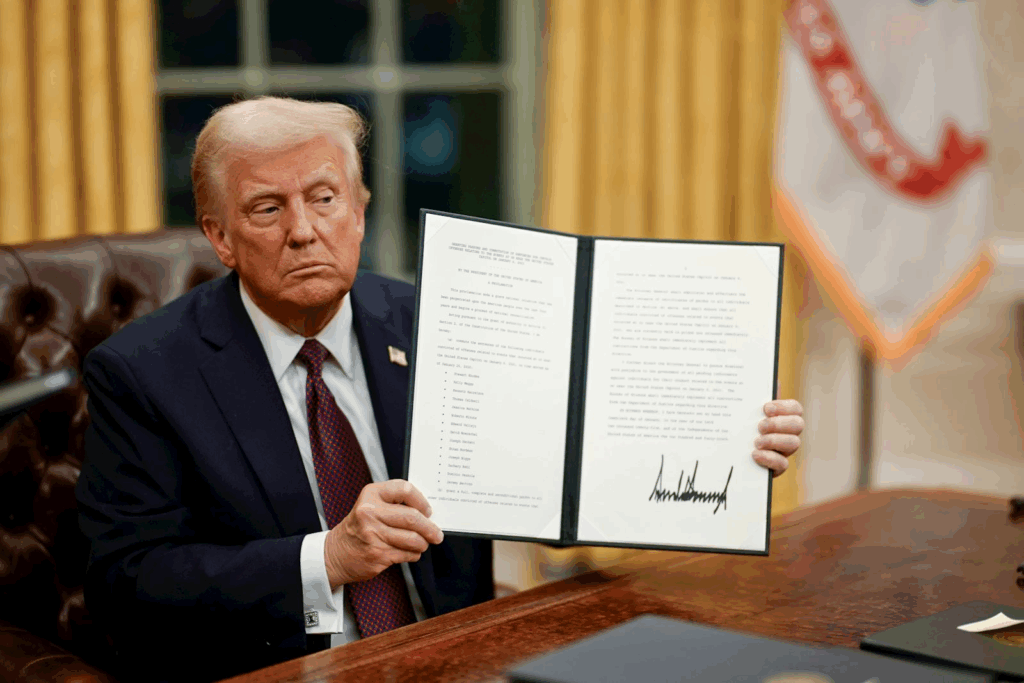Issue #107, Volume #2


Civil Wars Are Caused By Economics
This is Porter’s Daily Journal, a free e-letter from Porter & Co. that provides unfiltered insights on markets, the economy, and life to help readers become better investors. It includes weekday editions and two weekend editions… and is free to all subscribers.
| 20,000 casualties in a single day… The real cause of the first civil war… The second civil war could have millions of casualties… Social Security is not sustainable… The Fed cuts rates… CPI data lacks real facts… |
Today is the bloodiest day in America’s history.
On this day 163 years ago almost 90,000 Americans wearing blue coats fought, virtually to the last man, 50,000 Americans wearing grey coats. The Confederate States Army called the battle “Sharpsburg,” in reference to the nearby small Maryland town. But victors publish history books. Today, the battle is called “Antietam,” in reference to a small creek that runs through Sharpsburg’s cornfields to the Potomac River.
In the span of a single day, the Union suffered more than 12,000 casualties. The South suffered more than 10,000. Those 20,000-plus casualties brought to the world savagery on a new scale.
Antietam saw casualties equal to half of the total American casualties of the eight-year American Revolution 80-some years before.
And it foreshadowed even more carnage.
A year later, at another cornfield, more than 50,000 men would fall over three days at the battle of Gettysburg.
If you’d asked Americans in 1860 whether a civil war was coming, virtually all of them would have laughed and said it was impossible. And even if they realized there was the potential for such a conflict, they could have never imagined how many people would die – more than 700,000 people, including 100,000 civilians.
In America’s Second Civil War, the casualties will be dramatically worse. I believe it’s inevitable that millions of people will die. And I think that war has already begun.
Yes, I can hear you laughing. That’s okay. But print this out and hang on to it:
In the future, most historians will date the beginning of America’s Second Civil War to the fall of 2025.
Donald Trump’s and Charlie Kirk’s shootings are part of the reason. But the major milestone is the election of a Muslim communist to mayor of New York City in the fall of 2025.
That’s the start of this war.
It may be hard for you to perceive the extreme significance of these events, but that’s probably because you haven’t really thought much, in detail, about the inevitable collapse of the welfare state and how much chaos and violence that will bring.
By 2030, roughly 150 million Americans will be forced to support roughly 120 million dependents – people who either receive all or most of their incomes from the government, whether through employment or various benefit schemes.
This is a mathematical impossibility, but that will not stop the violence when Social Security fails.
If you doubt that will happen, just ask yourself this question: Why does the Social Security Administration disburse more money ($2.57 trillion) annually than all of the income taxes collected in the United States ($2.39 trillion) per year?

How long do you think that can continue?
And here’s something else I guarantee you don’t know (and no one is going to tell you):
There’s a legal limit to what Social Security is allowed to spend.
It is Public Law 74-271, 49 Stat. 620, codified at 42 U.S.C. §§ 301 et seq. The critical part is Title II, Section 207.
Way back in 1935, when President Franklin Roosevelt was steamrolling his socialist policies through Congress and threatening to pack the Supreme Court, conservatives fought back with this virtually unknown clause in the Social Security Act of 1935. This section explicitly mandates that old-age benefits (the core Social Security benefits at the time) were to be funded exclusively from the Old-Age and Survivors Insurance (OASI) Trust Fund.
When Social Security payments were extended to survivors (and other dependents) in 1939, this core limitation was, once again, codified. This additional law – 42 U.S.C. § 401(h) – reiterates that, regardless of the extended benefits, under Title II of the Social Security Act, all benefits of the program “shall be paid only from the Federal Old-Age and Survivors Insurance Trust Fund.”
And here’s the problem.
Congress dramatically increased the cost of these benefits with its 1972 reform of social security (Public Law 92-603, enacted on October 30, 1972). This reform introduced automatic cost-of-living adjustments (“COLAs”) for Social Security benefits, which became effective in 1975 and have taken place since, year after year, automatically.
The important thing to understand is this: Congress created an automatic annual increase in benefits, to match the government’s CPI-U index, but it never changed the funding mechanism.
And that means Social Security is going to run out of money.
No big deal, Congress can just pass a new law – right?
In theory… but look at the math.
It’s not possible for 150 million people to support 120 million people.
It’s not possible.
And all of this will come to a head in the next three to four years because, as inflation returns, the annual COLAs will deplete the OASI fund far faster than anyone has yet modeled. With inflation in excess of 6%, the OASI will be empty within four years.
What happens then?
Let’s review what happened in a Maryland cornfield 163 years ago. And… please… think about what really happened, not what your socialist history teacher told you.
With elections looming in November 1862, and with the North reeling from defeat after defeat (First Manassas Run, Seven Days, Second Manassas), another Union loss at Sharpsburg would have ended the war. President Abraham Lincoln would have been forced to make peace and America’s southern states would have retained their sovereignty.
Alas, Major General D.H. Hill’s copy of Confederate General Robert E. Lee’s battle plans (Special Orders #191) was lost in the march north outside of Frederick, Maryland. Union soldiers found the orders in a field, wrapped around three cigars.
America’s greatest general, Robert E. Lee, brought the war to the North, in part to relieve the pressure on his own capital (Richmond) but, even more importantly, to capture vital military stores at Harper’s Ferry. General Thomas “Stonewall” Jackson captured Harper’s Ferry three days before Sharpsburg. The surrender of 12,500 Union troops at Harper’s Ferry was the U.S. military’s greatest defeat, until the Battle of Bataan in 1942.
After the Civil Rights era, most Americans have been taught that the Civil War was about slavery. But virtually none of the troops on either side of Sharpsburg or Gettysburg (or any other civil war battle) were slave owners or abolitionists. They didn’t think they were fighting about slavery. In fact, President Lincoln promised to retain slavery in his 1861 inaugural address: “I have no purpose, directly or indirectly, to interfere with the institution of slavery in the States where it exists.”
The Civil War, like all wars, was about economics. And specifically, the war was about tariffs.
The trouble started in the 1820s.
Industrialists in the North sought high, protective tariffs to shield their factories from foreign competition, while the agrarian South, with its massive production of cotton and other raw materials, wanted low tariffs to ensure access to foreign markets. Funding the federal government with tariffs also ensured that the entire cost of the government was borne by the South.
Everyone wants more government spending. But nobody ever wants to pay for it. That’s as true today as it was in 1860.
The Tariff of 1828 was the real cause of the secessionist movement, not slavery. Dubbed the “Tariff of Abominations” by Southern critics, this act raised tariffs as high as 50% on imported goods. Vice President John C. Calhoun of South Carolina launched the Confederacy when he authored South Carolina Exposition And Protest, arguing that the tariff was unconstitutional and that states had the sovereign right to nullify (or void) federal laws they deemed harmful. This doctrine posited that the Union was a voluntary compact among states, not an indivisible nation.
South Carolina’s legislature called a state convention in November 1832 and adopted the Ordinance of Nullification. They declared the tariffs “null, void, and no law” within the state’s borders, effective February 1, 1833, and threatened secession if the federal government attempted to enforce them. The ordinance instructed state officials to ignore the tariffs and prepared militias for potential conflict.
President Andrew Jackson, a staunch Unionist, responded forcefully. In his Nullification Proclamation of December 1832, he denounced nullification as treasonous, affirming federal supremacy. Congress passed the Force Bill in March 1833, authorizing Jackson to use military force to collect tariffs, including deploying troops to Charleston Harbor.
The table was set for war, long before anyone mentioned ending slavery.
The crisis was defused by the Compromise Tariff of 1833, brokered by Senator Henry Clay and John C. Calhoun. It gradually reduced tariff rates over a decade (down to about 20% by 1842), allowing South Carolina to repeal its ordinance. But the issue was revived, again, in the late 1850s, with The Morrill Tariff.
Named after the bill’s sponsor, Representative Justin Smith Morrill of Vermont, this new tariff was introduced in 1860 to increase duties on a range of goods, including manufactured products, with rates as high as 47%. The passage of this bill became a fait accompli with the election of Abraham Lincoln as president. And that’s what led, first to South Carolina’s succession, and then other states, in support of South Carolina after the battle of Fort Sumter.
These facts aren’t taught anymore, because the last thing the federal government wants anyone to know is that the South was fighting for freedom from government oppression. It’s much easier to paint the South as evil if the war is about slavery.
And why does any of this matter today? Well, look at our current president. What’s he doing economically? Is he cutting taxes and spending and reforming our country’s massive entitlement programs?
No.
Instead, he has, by executive order (not with laws passed by Congress), instituted a slew of completely unconstitutional tariffs.
And that’s going to have a huge impact on America’s farmers, exactly like the Morrill Tariff crushed southern farmers in 1860.
During his first presidency, Trump’s actions triggered retaliatory tariffs on America’s exports, severely impacting America’s farmers. China, the largest buyer of U.S. soybeans, imposed 25% tariffs on American soybeans, causing exports to plummet 77% the following year. Overall, U.S. agricultural exports to China fell $27 billion between 2017 and 2019, with soybeans alone losing $11 billion in market share to competitors like Brazil and Argentina. The EU, Canada, and Mexico retaliated with tariffs on U.S. pork, whiskey, and dairy, leading to a 20% to 30% drop in those exports.
By 2020, total U.S. farm exports declined 13%, equivalent to a $40 billion loss, disproportionately affecting Midwest states like Iowa, Illinois, and Indiana. Net farm income fell 20% from 2013 peaks by 2020. Chapter bankruptcy 12 filings (for family farms) jumped 20% in 2019 and 24% in 2020, the highest since the 1980s farm crisis.
And, of course, this is all going to happen again.
Nothing ever changes.
Just the names of the places and the names of the people who died.
Trump To Open ‘Phase II’ Of The American Birthright?
President Trump has made a move to permanently open the floodgates of America’s mineral dominance, unleashing Phase II of the American Birthright. Historically, Phase II has been the most lucrative investing window across resource booms. The last time this happened, investors could’ve seen rare peak returns of 7,500%… 20,183%…even 140,000% in the span of 3 years. Trump is just days away from opening a new Phase II window. To know exactly what to do, get the complete Phase II strategy immediately HERE.
Three Things To Know Before We Go…
1. The Fed cuts for the first time in 2025. This afternoon, the Federal Open Market Committee (“FOMC”) cut interest rates by 25 basis points to a range of 4.00% to 4.25% as expected, noting that while it remains “attentive to the risks to both sides of its dual mandate” (inflation and unemployment), it believes “downside risks to employment have risen.” In its accompanying Statement of Economic Projections (aka the “dot plot”), most FOMC members foresaw two additional rate cuts this year.
2. Record high stock valuations. The U.S. stock market, measured by the S&P 500 index, is now trading at a 3.28x price-to-sales ratio – the highest valuation in history and more than double the 25-year average of 1.6x. At today’s prices, investors are pricing in a lot of good news.
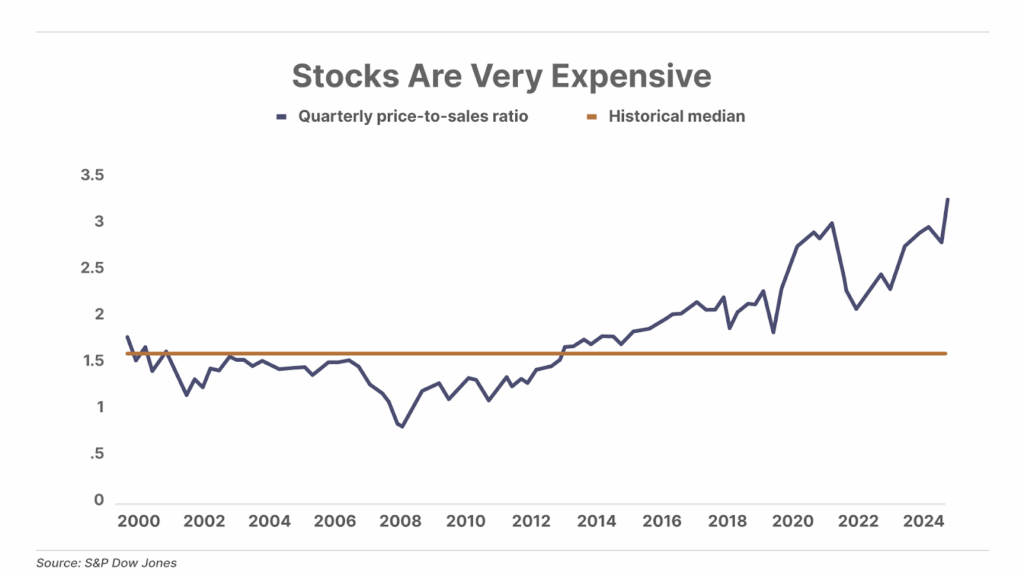
3. CPI is more fiction than fact. In August, 36% of consumer price index (“CPI”) data was estimated – up from 32% in July, and quadruple the 9% estimated a year earlier. Normally, the Bureau of Labor Statistics collects about 90,000 price quotes each month across 200 categories in 75 urban areas, with historically only around 10% estimated when actual data isn’t available. But since February, that share has jumped sharply. Now, more than a third of the CPI is based on estimates rather than actual prices – raising serious questions about the reliability of one of the U.S.’s most important economic indicators.
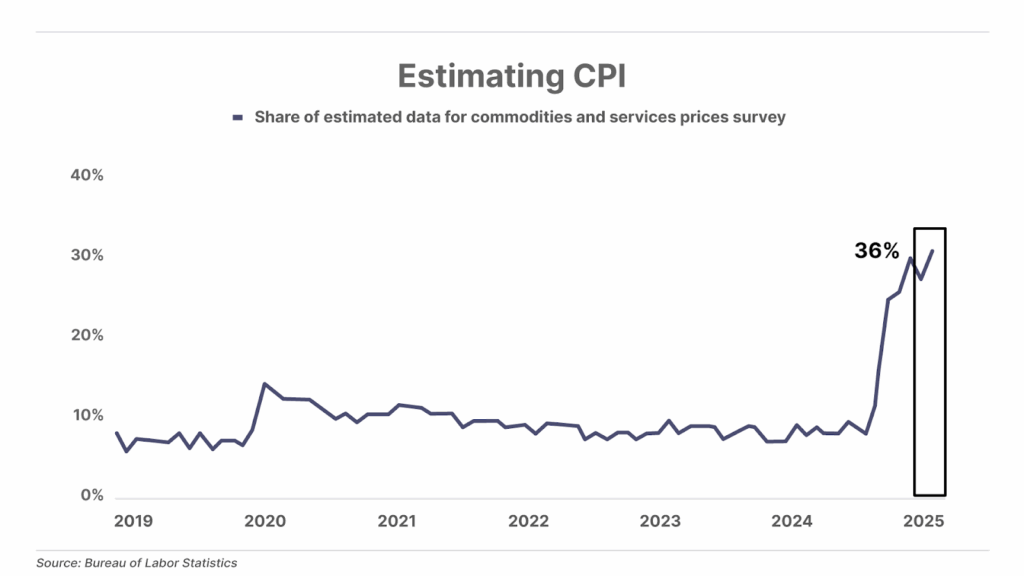
Tell me what you think: [email protected]
Good investing,
Porter Stansberry
Stevenson, Maryland
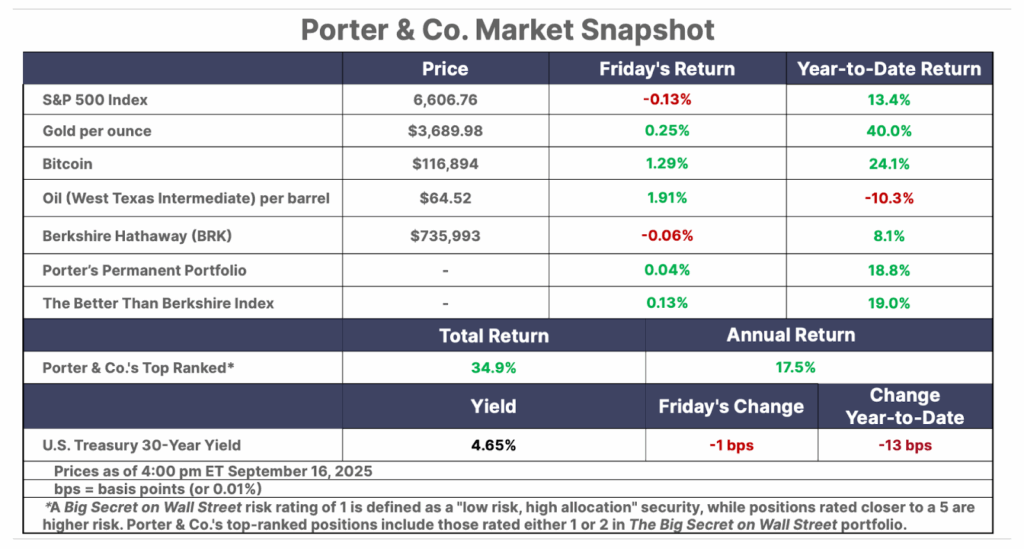
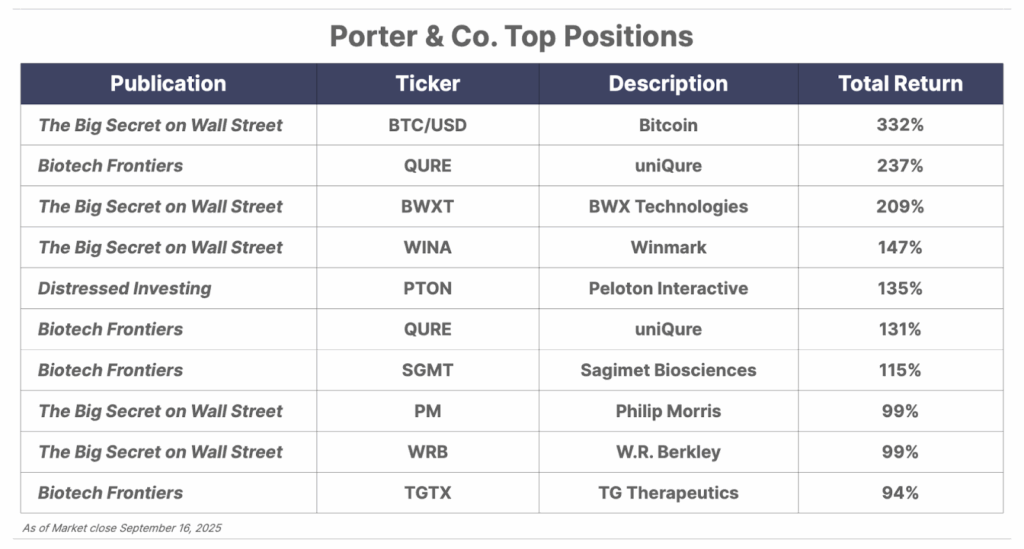
Please note: The investments in our “Porter & Co. Top Positions” should not be considered current recommendations. These positions are the best performers across our publications – and the securities listed may (or may not) be above the current buy-up-to price. To learn more, visit the current portfolio page of the relevant service, here. To gain access or to learn more about our current portfolios, call our Customer Care Team at 888-610-8895 or internationally at +1 443-815-4447.
